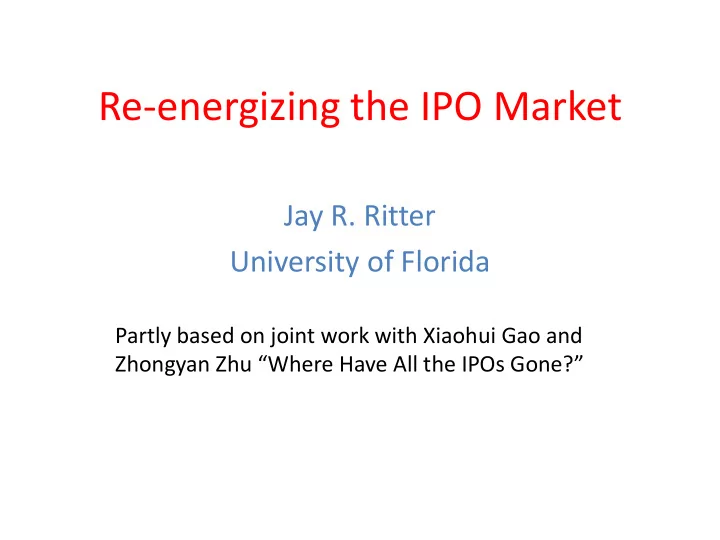

Re-energizing the IPO Market Jay R. Ritter University of Florida Partly based on joint work with Xiaohui Gao and Zhongyan Zhu “Where Have All the IPOs Gone?”
IPO volume has been very low in the U.S. since 2000 In 1980-2000, an average of 310 firms went public every year In 2001-2011, an average of 99 firms went public every year 800 80 700 70 600 60 Average First-day Returns, % Number of IPOs 500 50 400 40 300 30 200 20 100 10 0 0 Number of Offerings (bars) and Average First-day Returns (blue) on US IPOs, 1980-2011 2
Figure 1. The number of U.S. IPOs by year, 1980-2011, with pre-IPO last twelve months sales less than (small firms) or greater than (large firms) $50 million (2009 purchasing power). Reproduced from Gao, Ritter, and Zhu (2012).
IPO Exits for VC-backed firms have been limited from IPO Task Force slides, October 2011
50 25 S c a 40 20 l e d scaled IPO S h Q 30 15 i u l a l r e t r 20 10 e r P l E y 10 5 V a l u Shiller P/E e 0 0 Figure 2: The Shiller P/E ratio is taken from Robert Shiller’s website and is computed as the ratio of the S&P 500 index divided by the inflation- adjusted ten-year moving average of S&P 500 earnings. Scaled IPO volume is quarterly IPO volume divided by annual real GDP, in trillions of 2009 dollars.
Conventional Wisdom: The IPO Market Is Broken Sarbanes-Oxley Act of 2002 (SOX) has imposed costs on publicly traded firms, especially small firms Decimalization, Reg FD in 2000, and the Global Settlement in 2003 have led to a drop in analyst coverage for small firms, lowering their P/E ratios, and the collapse of the IPO ecosystem
We call these explanations The regulatory overreach hypothesis 7
Our Explanation: A Long-term Change Increased economies of scope Increased importance of speed to market Getting big fast is more important than in the past 8
The Consequence The profitability of small independent firms has declined relative to the value created as part of a larger organization that can quickly implement new technology and benefit from economies of scope. As a result, small firms are selling out rather than staying independent. 9
We call our explanation The economies of scope hypothesis 10
Our Evidence The percentage of small firms that are unprofitable has increased 70% 60% Without SOX costs Small firms 50% 40% 30% Large firms 20% 10% 0% Percentage of seasoned public companies with negative EPS, 1980-2009 11
Small firm IPOs have become less profitable 100% 90% 80% Small firm IPOs 70% 60% Large firm IPOs 50% 40% 30% 20% 10% 0% 1980 1981 1982 1983 1984 1985 1986 1987 1988 1989 1990 1991 1992 1993 1994 1995 1996 1997 1998 1999 2000 2001 2002 2003 2004 2005 2006 2007 2008 2009 Small firm IPOs Large firm IPOs Percentage of IPOs from the prior 3 years with negative EPS in fiscal year t Source: Table 2, columns 2 and 4 of Gao, Ritter, and Zhu “Where have All the IPOs Gone?” 12
Are recent IPOs going private more frequently? 6% 5% 4% 3% 2% 1% 0% Percentage of IPOs go private by year 3 Source: Table 7 (both LBOs and acquisitions by private firms) of Gao, Ritter, and Zhu (2012) 13
Young growth firms are more likely to be involved in an M&A transaction Either as an acquirer or being acquired Uptrend started in early 1990s
Evidence on post-IPO analyst coverage There is near universal analyst coverage on IPOs in 1994 to 2009 The percentage of small (grey) and large (red) firm IPOs with analyst coverage from at least one lead underwriter within one year of the IPO 100% 95% 90% 85% 80% 1994-2001 2002-2009 Source: Table 5, column 3 15
Figure 2. Price-earnings ratio of small company (annual sales less than $1 billion, 2011 purchasing power) and big company stocks with positive EPS (Before extraordinary items) traded on the Amex, Nasdaq, or NYSE with Compustat EPS data available. The price- earnings ratios are computed as the sum of the market values divided by the sum of the earnings for, respectively, small and big companies with positive EPS.
Policy Implications The stock exchanges and VC industry have argued that structural changes (e.g., subsidizing analyst coverage, lowering regulatory burdens) are needed to boost IPO activity Our analysis indicates that these will not be very effective at generating IPO activity
Policy Implications Our analysis suggests that companies are not going public because they have less value as a small independent company than as part of a larger organization 18
Conclusions No one explanation explains all of the prolonged drought in small firm IPOs in the U.S. SOX and Analyst Coverage explanations are of the category “The IPO market is broken” Our economies of scope explanation focuses on increased economies of scope and the importance of speed to market We focus not on public vs. private, but small vs. large firms as the profit-maximizing organizational form 19
Recommend
More recommend